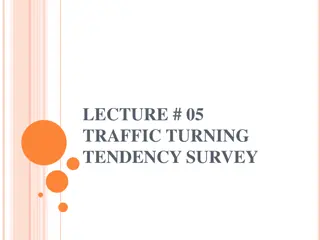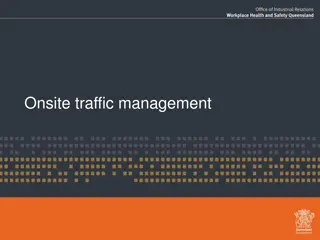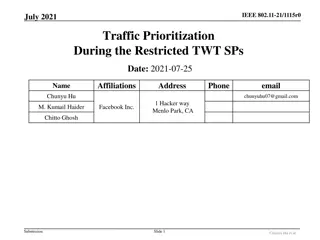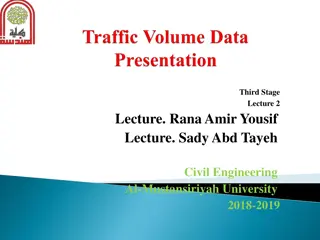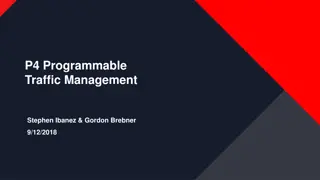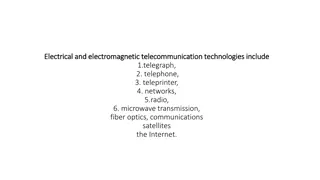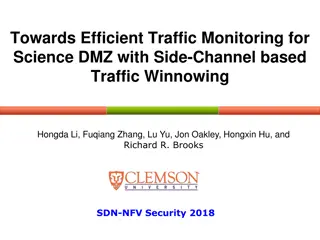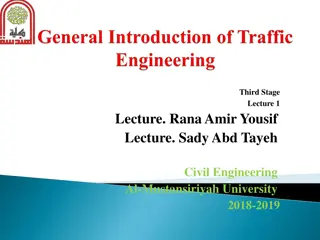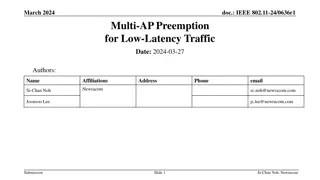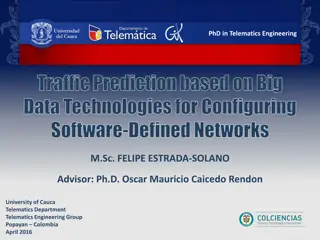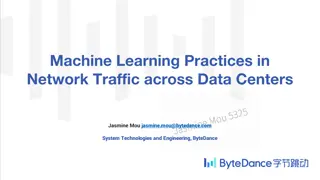Understanding Traffic Engineering Analysis in Telecommunication Networks
Traffic engineering analysis in telecommunication networks involves determining the network's capacity to carry traffic with a loss probability. Blocking probability, which is a key design concern, is influenced by various elements such as switching devices, digit receivers, call processors, and trunk links. The traffic load in a typical working day follows a characteristic pattern with peak hours corresponding to busy office activities and domestic calls. Network parameters like the busy hour and call completion rate play crucial roles in optimizing network performance.
- Traffic Engineering
- Telecommunication Networks
- Traffic Analysis
- Blocking Probability
- Network Parameters
Download Presentation

Please find below an Image/Link to download the presentation.
The content on the website is provided AS IS for your information and personal use only. It may not be sold, licensed, or shared on other websites without obtaining consent from the author. Download presentation by click this link. If you encounter any issues during the download, it is possible that the publisher has removed the file from their server.
E N D
Presentation Transcript
TRAFFIC ENGINEERING UNIT-III
Traffic Engineering Traffic engineering analysis enables one to determine the ability of a telecommunication network to carry agiven traffic ataloss probability. Blocking probability is the major issue for design. Not only the switching elements but also digit receivers, inter- stage links, call processors, trunk between links contribute in blocking of a call.
Variation of traffic on a typical working day In a telephone network, the traffic load in a typical working day during the 24 hours is shown in the fig. below.
The traffic pattern is same irrespective of the area considered. There is a little use of the network during 0 to 6 hours as most of the population is asleep. There is a large peak in the mid-forenoon and mid afternoon signifying busy office activities. The traffic is low during the lunch hour i.e 12 to 14 hours. The period 17 to 18 hours is characterized by low traffic as people are moving from office to their residences. After 18 hours the peak of domestic calls occur.
Network parameters Busy hour: In a day, the 60 minute interval during which the traffic is the highest is called the busy hour. Maximum number of calls are generated during the busy hour. It varies from exchange to exchange depending on locations and community interest of the subscribers. It may show seasonal, weekly and in some places daily variation.
There are three types of busy hour as recommended by CCITT in its recommendation E.600 : 1. Busy hour: Continuous 1 hour period lying wholly in the time interval concerned, for which the traffic volume or the number of call attempts is greatest. 2. Peak busy hour: The busy hour each day. It usually varies from day to day, or even over a number of days.
3. Time consistent busy hour: The 1 hour period starting at the same time each day for which the average traffic volume or the number of call attempts is greatest over the days under consideration. Call completion rate (CCR): Call completion rate is defined as the ratio of the number of successful calls to the number of call attempts. Note: A call attempt is said to be successful or completed if the called party answers.
The CCR parameter is used in dimensioning the network. A network is usually designed to provide an overall CCR of over 0.70. Busy Hour Call Attempts (BHCA): The number of call attempts in the busy hour is called busy hour call attempts. BHCA is an important parameter in deciding the processing capacity of a common control or a stored program control system of an exchange.
Busy hour calling rate: The busy hour calling rate is defined as the average number of calls originated by a subscriber during the busy hour. busy hour calling rate=average busy hour calls/total number of subscribers Busy hour calling rate is useful in sizing the exchange to handle peak traffic. P.1: An exchange serves 2000 subscribers. If the average BHCA is 10000 and the CCR is 60%, calculate the busy hour calling rate.
Day-to-busy hour traffic ratio: It is defined as the ratio of busy hour calling rate to the average calling rate for the day. Traffic intensity: For analytical treatment, all the common subsystems of a telecommunication network are collectively termed as servers. The traffic on a network can be measured in terms of occupancy of the servers in the network.
The traffic intensity is defined as the ratio of the period for which a server is occupied to the total period of observation. A0=(Period for which server is occupied)/(total period of observation) Generally, the period of observation is taken as 1 hour. A0 is dimensionless and is called erlang (E). A server is said to have 1 erlang of traffic if it is occupied for the entire period of observation.
P.2: In a group of 10 servers, each is occupied for 30 minutes in an interval of two hours. Calculate the traffic carried by the group. P.3: A group of 20 servers carry a traffic of 10 erlangs. If the average duration of a call is 3 minutes, calculate the number of calls put through a single server and the group as a whole in one hour period.
Traffic intensity can be measured in another way. This measure is known as centum call second (CCS) which represents call-time product. One CCS may mean one call for 100 seconds duration or 100 calls for one second duration each or any other combination. CCS is valid only in telephone circuits (from subscribers point of view). Erlang provides better measure for representing traffic intensity (from exchange point of view).
Sometimes Call seconds (CS) and Call minutes (CM) are also used to measure traffic intensity. 1E=36 CCS=3600 CS=60 CM P.3: A subscriber makes three phone calls of 3 minutes, 4 minutes and 2 minutes duration in a one-hour period. Calculate the subscriber traffic in erlangs, CCS and CM. P.4: Over a 20 minute observation interval, 40 subscribers initiate calls. Total duration of the calls is 4800 seconds. Calculate the load offered to the network by the subscriber and the average subscriber traffic.
There are two more parameters that are required to estimate the traffic intensity or the network load and these are: Average call arrival rate, C (in number of calls per minute) i. Average holding time per call, th (minutes per call) ii. The load offered to the network in terms of the above parameters can be expressed as, A=Cth
Notes: The traffic is being handled in two ways: i. Based on the traffic generated by the subscriber ii. Based on the observation of busy servers in the network.
Handling of overload traffic There are two ways of handling overload traffic. loss systems and delay systems are introduced depending on these two ways of handling traffic.
loss systems: In loss system, the overload traffic may be rejected without being serviced. calls are lost. Automatic telephone exchanges behave like loss systems. Circuit switched networks are loss systems. Performance parameters are grade of service and blocking probability. Traffic models used to study loss systems are known as blocking or congestion models.
Delay system: In delay systems, the overload traffic is held on a queue until network facilities become available. Calls are delayed. Operator-oriented manual exchanges are delay systems. Store-forward message or packet switched networks are delay systems. Performance parameter is service delays. Traffic models used to study delay systems are known as queuing models.
Grade of service (GOS) In loss systems, the traffic carried by the network is generally lower than the actual traffic offered to the network by the subscribers. The overload traffic is rejected. The amount of traffic rejected by the network is an index of quality of service by the network. This termed as grade of service (GOS).
The GOS is defined as the ratio of lost traffic to the offered traffic. Offered traffic is the product of average number of calls (A) generated by the users and the average holding time per call (th). The actual traffic carried by the network is called the carried traffic. Accordingly GOS is given by, GOS=(A-A0)/A where, A=offered traffic A0=carried traffic A-A0=lost traffic
Smaller the value of GOS, better is the service. The recommended value of GOS in India is 0.002. GOS 0.002 means that two calls in 1000 calls or one call in 500 calls may be lost.
Differences between Blocking probability and GOS It may appear that blocking probability (PB) is same as GOS but they are not same. PB is defined as the probability that all the servers in a system are busy. Whereas, GOS is defined as the fraction of calls lost. PB is arrived at by observing the busy servers, whereas, GOS is arrived at by observing the number of rejected subscriber calls in a switching system.
In a system with equal number of servers and subscribers, GOS is zero but there is a definite probability that all the servers are busy at a given instant and hence PB is not zero. GOS is measure from subscriber point of view whereas, PB is a measure from the network point of view. GOS is called call congestion or loss probability and PB is called time congestion.
Why GOS is zero for delay systems In case of delay systems, the traffic carried by the network is same as the load offered to the network by the subscriber. Since the overload traffic is queued, all calls are put through network as and when network facilities are available. So, GOS is not meaningful in the case of delay systems and is zero always. The probability that a call experiences a delay, is called delay probability.
Modelling Switching Systems A telecommunication network carries traffic generated by a large number of individual subscribers connected to the networks. Subscriber generate calls in a random manner. The call generation and therefore the behavior of the network or the switching network in it can be described as a random process.
A random process or a stochastic process is one in which one or more quantities vary with time in such a way that the instantaneous values of the quantities are not determined precisely but are predictable with certain probability. These quantities are called random variables. Types of stochastic processes: Continuous time continuous state Continuous time discrete state Discrete time continuous time Discrete time discrete state
Random processes whose statistical parameters do not change with time are known as stationary processes. The random processes which have identical time and ensemble averages are known as ergodicprocesses. In some random processes, the mean and variance are stationary and the higher order moments may vary with time, such processes are known as wide-sense-stationary processes.
Markov processes Markov process is an important class of random processes that have some special properties. The properties were defined by A.A Markov in1907. This class of processes is of great interest to the modelling of switching systems. A discrete time Markov chain or discrete time discrete state Markov process is defined as one which has the following property: = = = = [{ ( ) } /{ ( ) , ( ) ,..., ( ) }] 1 x P X t x X t x X t x X t + + 1 1 1 1 1 n = n n n n n = = [{ ( ) } /{ ( ) }] P X t x X t x + + 1 1 n n n n
Where, t1<t2.<tn<tn+1 and xi is the i-th discrete space variable. The equation states that the random variable X takes on the value xn+1 at time step n+1 is entirely determined by its state value in the previous step n and is independent of its state values in earlier time steps; n-1,n-2,n-3 the etc. The entire past history of the process is summerised in its current state and hence next state is determined only by current state.
P.4: During a 2 hour busy period, 2400 calls arrive at an exchange. Average holding time per call is two minutes. What is the traffic load in (a) erlangs, (b) CCS P.5: A call processor in an exchange require 120 ms to service a complete call. What is the BHCA rating for the processor, if the exchange is capable of carrying 700 erlang of traffic? What is the call completion rate? Assume average call holding time of two minutes.
P.6: In an exchange, the calls arrive at the rate of 1100 calls per hour, with each call holding for a duration of three minutes. If the demand is serviced by a trunk group of 50 lines, determine GOS. P.7: An exchange designed to handle 2000 calls during the busy hour. One day the number of calls during the busy hour is 2200. What is the resulting GOS?
P.8: The traffic statistics of a company using a PABX indicates that 180 outgoing calls are initiated every hour during working hours. Equal number of calls come. Each call lasts for 200 seconds on the average if the GOS required is 0.05, determine the number of lines required between the PABX and the main exchange.
Three aspects while dealing with the analysis of telecommunication systems: Modelling the system Traffic arrival model Service time distribution Three models of loss systems Lost calls cleared (LCC) Lost calls returned (LCR) Lost calls held (LCH)
Lost Calls Cleared System with Infinite Resources Lost Calls Cleared System with Finite Subscribers Lost Calls Returned System Lost Calls Held System
Three aspects while dealing with the analysis of the telecommunicationsystems: Modelling System Traffic ArrivalModel Service time distribution Overflow traffic may be handled in three ways: o the traffic rejected by one set of resources may be cleared by another set of resources in the network. o The traffic may return to the same resource after sometime. o The traffic may be held by the resource as if being serviced but actually serviced only after the resources become available.
1. Lost calls cleared (LCC) 2. Lost calls returned (LCR) 3. Lost calls held (LCH)
Offered traffic comprises of two components: Offered traffic= new traffic+ retry traffic Taking into call the returning calls, LCR model is designed. Following assumptions are made: No new call is generated when a blocked call is being retried. A number of retry attempts may be involved beforea call eventually gets serviced. Retries are attempted after a random time and each retry time is stastically independent of the others. Typical waiting time before a retry is longer than the average holding time.



